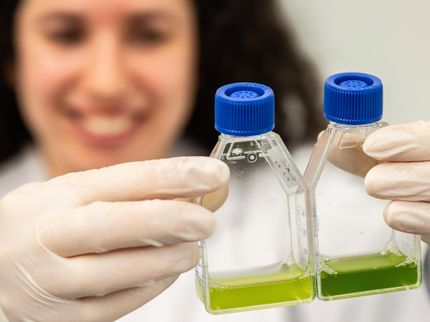Fusion protein controls design of photosynthesis platform
Collaborative project uncovers the role of a protein in the formation and maintenance of the inner membrane structures of photosynthetic systems
chloroplasts are the solar cells of plants and green algae. In a process called photosynthesis, light energy is used to produce biochemical energy and the oxygen we breathe. Thus, photosynthesis is one of the most important biological processes on the planet. A central part of photosynthesis takes place in a specialized structure within chloroplasts, the thylakoid membrane system. Despite its apparent important function, until now it was not clear how this specialized internal membrane system is actually formed. In a collaborative project, researchers at Johannes Gutenberg University Mainz (JGU) in Germany have now identified how this membrane is generated. According to their findings, a protein called IM30 plays a major role by triggering the fusion of internal membranes. The study elucidating the role of IM30 involved biologists, chemists, biochemists, and biophysicists at Mainz University and the Max Planck Institute for Polymer Research. Their results have recently been published in the journal Nature Communications.
Chloroplasts are organelles found in higher plants and green algae. They contain an internal membrane system, so-called thylakoid membranes, where the key processes of photosynthesis take place. "A detailed understanding of photosynthesis and the associated molecular processes is essential to properly comprehend life on our planet," emphasized Professor Dirk Schneider of the Institute of Pharmaceutical Sciences and Biochemistry at JGU, who coordinated the study. "Despite the significance of the process, we know almost nothing about how these special membranes are formed and maintained." It had not previously been possible to identify a single fusion-mediating protein in photosynthetic cells, even though it was perfectly clear that such proteins have to be involved in the development of thylakoid membranes.
With this in mind, the Mainz-based research team isolated and investigated the protein IM30 from a blue-green alga, which might be classified as a "free-living chloroplast." IM30 – the "IM" stands for "internal membrane" while 30 is its atomic mass (30 kilodaltons) – was first described in the mid-1990s and it was demonstrated that it binds to internal membranes. Thanks to the combined expertise of the teams headed by Professor Dirk Schneider, Professor Jürgen Markl of the JGU Institute of Zoology, and Professor Tobias Weidner of the Max Planck Institute for Polymer Research it has now emerged that IM30 forms a ring structure that specifically interacts with phospholipids of the membranes. "This binding alters the membrane structure and under certain conditions can lead to membrane fusion," explained Schneider. In absence of IM30, thylakoid membranes are noticeably deteriorated, which can subsequently lead to loss of cell viability. The IM30 fusion protein provides a starting point for future research, unraveling new types of membrane fusion mechanisms in chloroplasts and blue-green algae.
Original publication
Other news from the department science
These products might interest you

Hahnemühle LifeScience Catalogue Industry & Laboratory by Hahnemühle
Wide variety of Filter Papers for all Laboratory and Industrial Applications
Filtration Solutions in the Life Sciences, Chemical and Pharmaceutical Sectors

Hydrosart® Ultrafilter by Sartorius
Efficient ultrafiltration for biotech and pharma
Maximum flow rates and minimum protein loss with Hydrosart® membranes

Hydrosart® Microfilter by Sartorius
Hydrophilic microfilters for bioprocesses
Minimal protein adsorption and high flow rates

Sartopore® Platinum by Sartorius
Efficient filtration with minimal protein adsorption
Reduces rinsing volume by 95 % and offers 1 m² filtration area per 10"

Polyethersulfone Ultrafilter by Sartorius
Reliable filtration with PESU membranes
Perfect for biotechnology and pharmaceuticals, withstands sterilisation and high temperatures

Polyethersulfone Microfilter by Sartorius
Biotechnological filtration made easy
Highly stable 0.1 µm PESU membranes for maximum efficiency

Sartobind® Rapid A by Sartorius
Efficient chromatography with disposable membranes
Increase productivity and reduce costs with fast cycle times

Get the life science industry in your inbox
By submitting this form you agree that LUMITOS AG will send you the newsletter(s) selected above by email. Your data will not be passed on to third parties. Your data will be stored and processed in accordance with our data protection regulations. LUMITOS may contact you by email for the purpose of advertising or market and opinion surveys. You can revoke your consent at any time without giving reasons to LUMITOS AG, Ernst-Augustin-Str. 2, 12489 Berlin, Germany or by e-mail at revoke@lumitos.com with effect for the future. In addition, each email contains a link to unsubscribe from the corresponding newsletter.


















































